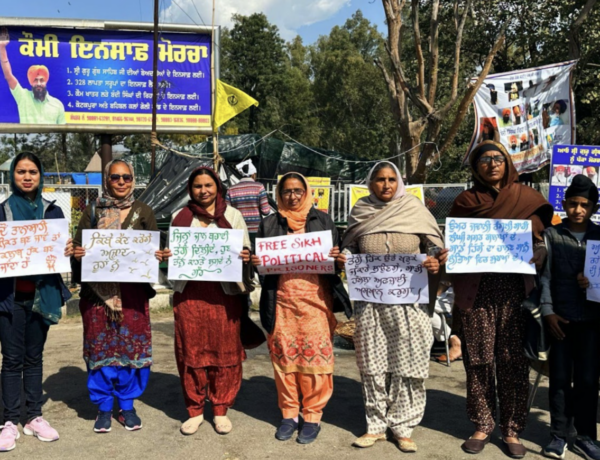by Japjyot Singh
This article is expansion on the previous work of Arunima, Harnoor Singh, Tavleen Kaur, and prabhdeep singh kehal. I was absolutely enthralled by these writers’ work, and present to you a personal reflection on the development of gender in ਸਿੱਖ (Sikh) philosophy.
Why Do We Deny Our Fullness?1
ਗੁਰ ਕਾ ਬਚਨੁ ਬਸੈ ਜੀਅ ਨਾਲੇ ॥ ਜਲਿ ਨਹੀ ਡੂਬੈ ਤਸਕਰੁ ਨਹੀ ਲੇਵੈ ਭਾਹਿ ਨ ਸਾਕੈ ਜਾਲੇ ॥੧॥ ਰਹਾਉ ॥
gur kaa bachan basai jeea naale || jal nahee ddoobai tasakar nahee levai bhaeh na saakai jaale ||1|| rahaau ||
The Word of the ਗੁਰੂ ਸ਼ਬਦ2 (Guru Shabad) resides within my spirit, now and always. The ਸ਼ਬਦ2 (Shabad) cannot be drowned, it cannot be stolen by thieves, it cannot be burned away with flames. (It lives in the spirit, forever!)
– ਮਹਲਾ ੫3 (Guru Arjan Sahib, Ang 679)
ਵਾਹਿਗੁਰੂ4 isn’t a “He”
Whenever I thought of ਵਾਹਿਗੁਰੂ4 (Vaheguru) as a child, I couldn’t help but translate the Name for Universal, Eternal, Everlasting, Divine Truth without using “He”. It’s only been in the last 5-7 years that my pre-conceived beliefs on gender and gender expression have been significantly challenged and transformed through ਗੁਰਮਤ5 (Gurmat). While this transformation can only be credited to ਗੁਰੂ ਸਾਹਿਬ6 (Guru Sahib), I must give my thanks to the ਸੰਗਤ7 (Sangat) ਗੁਰੂ ਸਾਹਿਬ6 (Guru Sahib) gave me to help move that shift forward.
What is the exact significance of moving beyond “He”? Since the Divine Truth of ਵਾਹਿਗੁਰੂ4 (Vaheguru) has no form that can be attributed to Them, the same lesson applies to the perceived self. ਗੁਰੂ ਸਾਹਿਬ6 (Guru Sahib) is quite clear when it comes to the destruction of self – it requires removal of doubt, duality, and of a “self” at all. Embracing the ਗੁਰੂ6’s (Guru’s) path is the destruction of personal choice, it is the destruction of the world’s path, and it is the destruction of your mind. We embrace Oneness as our sole goal, and the love of this Oneness as our hope and purpose. In relation to gender, ਗੁਰੂ ਸਾਹਿਬ6’s (Guru Sahib’s) conception of gender was re-molded by ਗੁਰਬਾਣੀ8 (Gurbani) and Their ਕਰਮ9 (karam). No longer did the women of the ਪੰਥ10 (panth) live in a strict binary of “hunter and gatherer” or “worker and householder,” they were uplifted by ਗੁਰੂ ਸਾਹਿਬ6 (Guru Sahib) and empowered themselves with the potential that always lived with them.
Moving Beyond a Masculine Divine
The longer we conceive of ਵਾਹਿਗੁਰੂ4 (Vaheguru) as exclusively “male,” we implicitly deny at least half of our potential. It is beyond just talk of the spirit; by talking of the Divinity within us as “male”-identifying only, we ignore the intricacies of the vessels we inhabit.
For instance, consider Arunima‘s reflections, “We can understand the gender/sex binary as a mayaic manifestation of dvait, duality, or dooja bhav. If you don’t yet know, cell biologists have recently verified that humans’ sex characteristics are not simply either ‘male’ or ‘female’. “The idea of two sexes is overly simplistic” because in fact each human being’s corporeality is uniquely varied. Our body has an ever-changing composition, alongside a long-lasting interplay between evolving genetic, cellular, and genital characteristics.”
The male and female binary is constructed by the West to solidify a division of human spirit – we begin our lives with diminished potential because how else do you ensure the control of the people around you? However, ਗੁਰਬਾਣੀ8 (Gurbani) is fluid when discussing the feminine and masculine. To weave back and forth within the spectrum of gender identity is a testament to the freedom in which ਗੁਰੂ ਸਾਹਿਬ6 (Guru Sahib) lived Their lives. It is a legacy of the developing attitudes and practices within the ਖ਼ਾਲਸਾ11 ਪੰਥ10 (Khalsa Panth).
A notable example is how ਗੁਰੂ ਸਾਹਿਬ6 (Guru Sahib) uses relationships in ਗੁਰਬਾਣੀ8 (Gurbani). Many individuals interpret that ਗੁਰੂ ਸਾਹਿਬ6 (Guru Sahib) only speaks to relationships between husbands and wives in ਗੁਰਬਾਣੀ8 (Gurbani), but I challenge you to ask: is it and was it always that simple? If we assume that ਗੁਰੂ ਸਾਹਿਬ6 (Guru Sahib) exclusively identified as male, especially within our modern conception of masculinity, then how could They have possibly written from the identity of the “ਸੁਹਾਗਣਿ12” (Suhaagan)? In other words, how could they have adopted the identity of a “female” lover awaiting their “beloved husband?” Understanding identity/identification here is important because the reason ਗੁਰਬਾਣੀ8 (Gurbani) grasps at the deepest pockets of the human mind and heart is because it delves into the roots of identity without any limitation. ਗੁਰਬਾਣੀ8 (Gurbani) is devoid of duality because it is the ultimate practice of Oneness. ਗੁਰੂ ਸਾਹਿਬ6 (Guru Sahib), and other lovers of the Divine, laid their thoughts bare and without any restraint. They became the ਸੁਹਾਗਣਿ12 (Suhaagan = bride). Their longing for their Beloved was as raw, emotional, passionate and romantic as any partner awaiting their lover. Thus, given Their context, They used the example of a loving wife awaiting her beloved husband – but They Themselves adopted the identity of the female lover. This example of ਸੁਹਾਗਣਿ12 (Suhaagan) is one that moves beyond just the feminine understanding – it becomes one that is now associated with all souls, regardless of their physical being. ਗੁਰੂ ਸਾਹਿਬ6’s (Guru Sahib’s) identity is steeped in Oneness, so much so that adopting gender became a fluid, living process.
This method of fluidity has only been named by the West in the past 30 or so years, and yet ਗੁਰੂ ਸਾਹਿਬ6 (Guru Sahib), and many other ਭਗਤ13 (Bhagat) and ਸੰਤ13 (sant), constantly molded and formed their identity through the masculine and feminine seamlessly. Gender fluidity, as we call it more formally now, is a concept that aligns deeper with ਗੁਰਮਤ5 (Gurmat) than we realize. We exist on a spectrum of masculine and feminine because ਵਾਹਿਗੁਰੂ4(Vaheguru)/ਗੁਰੂ6(Guru)/ਸਤਿਗੁਰੂ14 (Satguru) has no shape, no form, no gender, etc. We are all housing an eternal, love-steeped spirit that has no care for any physical form. ਗੁਰਮਤ5 (Gurmat) asks the mind to let go of all worldly attachments and still exist within it at the same time – for how else can we begin to accept that we are both masculine and feminine all the time? How else can we begin to move beyond the limitations the world puts on us?
Addressing Our Limitations to Move Beyond
ਸਿੱਖੀ15 (Sikhi) is powerful, but its practice is subjugated in the minds of the people. This subjugation causes us to exist in a lower state of being, and is constantly implemented through many methods, of which we cannot speak to extensively in this article but have chosen to focus on the gender binary. Understanding this lower state of being is crucial because it is the attitude/mentality that denies us of our ability to appreciate our fullness, to appreciate the myriad of ways that we can exist, act, and change the world. It is so second nature to us that we often go decades without recognizing its hold on our consciousness.
For example, in examining the effects of the gender binary, I am perturbed when I see a ਸਿੰਘ16 (Singh) do ਸੇਵਾ17 (seva) in ਗੁਰੂ ਕਾ ਲੰਗਰ18 (Guru ka Langar) but he cannot do the same in his own kitchen. We do not recognize that the ਸੇਵਾ17 (seva) we do in both of these kitchens are one and the same. I shudder to think of how the ਸਾਖੀ19 (saakhi) of ਭਾਈ ਲਾਲੋ ਜੀ20 (Bhai Lalo Ji) would differ had he believed his kitchen was not his own to contribute to.
Another example of the effects of the gender binary are conversations of ਕੇਸ21 (kesh) for ਸਿੰਘ16 (Singh) and ਕੌਰ22(Kaur). “However, it seems that specifically the cis-male, heterosexual ਸਿੰਘ (Singh) of our community are blinded to the hypocrisy of espousing the beauty of being ਕੇਸਾਧਾਰੀ (ਕੇਸhdhari – one who keeps their hair) and the value of maintaining each ਰੋਮ (rom – body hair) on the body while also preferring to have a partner who only has ਰੋਮ (rom – body hair) where it is visually pleasing to them,” (Harnoor Singh). This idea that the physical manifestation of the ਖ਼ਾਲਸਾ11 (Khalsa) belongs to no other than a ਸਿੰਘ16 (Singh) is absolutely contrary to ਗੁਰਮਤ5 (Gurmat). By limiting certain standards or experiences of ਸਿੱਖੀ15 (Sikhi) to masculine-identifying people, we will constantly be plagued by the embarrassment that we have lessened the value of the great ਕੌਰ23 (Kaur) figures of our past – that we have sunken so low as to believe the ਗੁਰੂ6 (Guru) only created the ਖ਼ਾਲਸਾ11 for the cis-male heterosexual people of the world.
Conversations on masculinity and femininity are frustrating within ਸਿੱਖ23 (Sikh) circles because we are still grappling with the miseducation we received at the hands of colonizers. However, a prolific ਸਿੱਖ22 (Sikh) writer once mentioned that when the ਗੁਰੂ6 (Guru) decided to use a widely known word in their ਗੁਰਮਤ5 (Gurmat) context, the word itself became Theirs, and what a beautiful thought! The power of the ਗੁਰੂ6 (Guru) was such that all systems of power bent to Their will. They created all things anew and within the reflection of the Master of All.
It is within this context that we must re-educate and reflect on ourselves. The process of that re-education can be maddening, but it is important to take the antidote after being fed poison for so long. I would urge those who have read through this article to do the following:
- Reflect deeply on the gender roles and norms you have been taught all your life.
- Read the histories of the communities and countries you live in and critically examine the ways different communities or groups of people – particularly in regard to gender – have been subjugated for centuries under the guise of advancement and “savior”-hood.
- Listen to the voices of the femme-identifying figures in your life.
Then, when you feel the discomfort of the weight people must carry with being and identifying as feminine in our current world, you will finally begin your understanding of the reasons why we must move beyond defining our ਗੁਰੂ6 (Guru) and ourselves behind a gender binary.
About Japjyot Singh
Japjyot Singh (he/they) currently works in the field of addressing gender-based violence. Amidst this work, they are constantly learning the ways in which Gurmat can and should be incorporated in ensuring an anti-oppression, equitable, loving, and justice-based approach for community growth and healing. They hope to learn from the Sangat in how to best enact and practice the Guru’s vision.
Footnotes
[1] An expansion on the previous work of Arunima, Harnoor Singh, Tavleen Kaur, and prabhdeep singh kehal. I was absolutely enthralled by these writers’ work, and present to you a personal reflection on the development of gender in ਸਿੱਖ (Sikh) philosophy.
[2] Guru Shabad: The writings of the Sikh Gurus. In the Sikh belief system, these are Divine reflections, gifted to the Guru through the Divine Immortal.
[3] Mehala 5: The Fifth Master, Guru Arjan Dev ji. This is being used to attribute the previous Gurbani reference to the 5th Guru.
[4] Vaheguru: The Divine Immortal. The Greatest Enlightener. The Sikh term for the highest being in existense.
[5] Gurmat: The way of the Guru. The path of every Sikh must be walked through the intellect, behavior, mode of the Guru.
[6] Guru Sahib: A term of respect and love, Sahib is added in respect to one of royalty, one of power. This phrase emphasizes respect to the Guru by recognizing their inherent sovereignty.
[7] Sangat: The community. The congregation. Term used in reference to the Sikh community, and in some contexts to the general community around oneself.
[8] Gurbani: Interchangeable with Guru Shabad.
[9] Karam: One’s deeds or actions
[10] Panth: another word referring to the Sikh community, but in a much larger and broader sense.
[11] Khalsa: Term can be used alone or with ‘Panth.’ Refers again to the Sikh community, but is more rooted in exemplifying the sovereign nature of the Sikh people. Also refers to the Sikhs who have been initiated through Amrit Sanchaar. This was a practice established through the 10th Guru of the Sikhs, Guru Gobind Singh ji. They, through the culmination of the 9 Gurus before them and the establishment of Guru Granth Sahib, entrusted the Amritdhaaris with the sovereign, spiritual, and political power of the Guru.
[12] Suhaagan: In reference to a bride. Used in Gurbani as the identity of the soul, yearning to be with their “Husband” – Vaheguru.
[13] Bhagat/Sant: Terms used to refer to the lovers and practitioners of the Divine. Individuals believed to have attained/connected with the Divine Being.
[14] Sathiguru: Another term for Vaheguru and Guru; interchangeable.
[15] Sikhi: The original term used to describe the way of the Sikhs. Not interchangeable with ‘Sikhism’, the colonizers approach to boxing in the Sikh nation.
[16] Singh: Often attributed to a male-expressing person on the Sikh path.
[17] Seva: act of service, done through humility and in remembrance of the One Timeless, Eternal Divine.
[18] Guru ka Langar: Langar here is used to describe, simply, a free kitchen. Refers to the practice of the Guru which established an open and free communal space for people to be served food, without any regard for personal factor.
[19] Saakhi: Term for Sikh history, often told in story/narrative forms.
[20] Bhai Lalo Ji: A Sikh from the life of Guru Nanak Dev ji (1st Guru of the Sikhs).
[21] Kes: Term used for the uncut (in all the ways) hair on the body of a Sikh.
[22] Kaur: Often attributed to a feminine-expressing person on the Sikh path.
[23] Sikh: A follower of the 10 Sikh Gurus, Guru Granth Sahib, and exhibits a belief in One Timeless, Formless Creator. A more detailed definition can be found in the Sikh Guide of Conduct, the Rehat Maryada.





No Comments